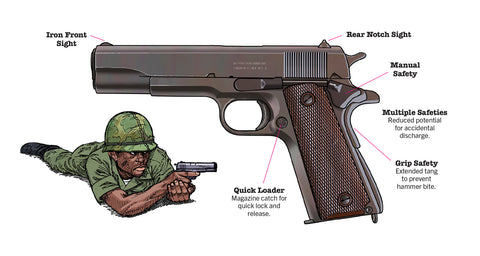
The M1911/1911A1 Served as America’s Military Sidearm From 1911 to 1984
On July 18, 1966, Staff Sgt. John McGinty led the understrength 1st Platoon of K Company, 3rd Battalion, 4th Marine Regiment against a regimental-sized North Vietnamese Army (NVA) force supported by mortar fire. The NVA hoped to overrun 3rd Battalion’s Landing Zone Crow to stop the battalion’s withdrawal following Phase I of Operation Hastings.
It quickly became a chaotic, close-range fight. McGinty directed air strikes to within 50m of his position and called in final defensive artillery fire. He and 20 of his 32 Marines were wounded and his corpsman killed in the fighting. The enemy finally withdrew that evening. McGinty and his company commander, Capt. Robert J. Modrzejewski, received the Medal of Honor for their actions that day. Although air and artillery power turned the tide of battle, McGinty’s sidearm, the M1911A1, had delivered critical punching power during key moments in the hard fight.
Based on John Browning’s short-recoil operated, .38-caliber, self-loading (i.e. automatic) pistol of 1900, the M1911 gained its designation from the year the U.S. Army adopted it. Intended for close-range engagements in dense terrain, the Army ordered the caliber increased to .45 because the .38 round lacked the power to stop the assaults of Moro tribesmen during the Philippine- American War. It had a 7-round magazine in the grip. Many placed an eighth round in the firing chamber. Grip and manual safeties, sear disconnect, slide stop, and half-cock features were added in 1924 and this model was officially designated the M1911A1 in 1926.
Approximately 7,028,690 have been produced to date, including the RIA M15 General Officer’s sidearms (1972-1981). There were only 1,004 GO model M15s ever produced. The M15 was a shortened version of the M1911A1. These were not newly produced but were all cut-down from carefully selected original M1911A1s, many from the National Match version. The M1911A1’s punching power is unchallenged, but its recoil necessitates training to fire accurately.
By 1969, the majority of M1911A1s were suffering from decades of heavy use. Congress ordered the Pentagon to choose a new standard military pistol. The Army selected the 9mm Beretta 92S1 in 1984. The M1911/1911A1 served as America’s basic military sidearm from 1911 to 1984. It remains so in the armed forces of over 40 nations today. More importantly, U.S. Special Operations Forces continue to use specialized versions of the venerated .45 to this day.
M1911A1
Designation: M1911A1
Weight (loaded): 1.36kg/3lbs
Length (overall): 219mm/8.5”
Caliber: 0.45 ACP (Automatic Colt Pistol)
Barrel Length: 128mm/5.03”
Max. Rate of Fire: 25 rpm
Ammunition: 230 grain
Muzzle Velocity: 252mps/825fps
Effective Range: 25m/27.5yds
Max. Range: 150m/165yds
